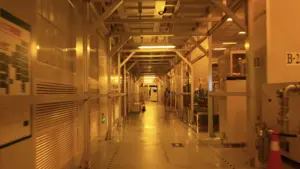I don’t usually write these sort of articles on Display Daily but we have a few guys on break and the boss decided to write a rant about OLED manufacturing and FMM that got me thinking and I thought I probably need to find out what the heck is he going on about.
After talking to the man, it seems clear that he has a gripe about the level of attention and investment in ink jet printing technology. But, he gets like that. I think it has as much to do with the traditional models of investment in display manufacturing versus his need to feel excited about the future of displays.
I have tried to do a comparison of sorts because I know how to use the Internet but I tried to go beyond that superficial look as well.
| Feature | Inkjet Printing Advantages | FMM Advantages |
|---|---|---|
| Material Efficiency | Higher material utilization, reducing waste. Especially beneficial for OLED displays where organic materials are costly. | – |
| Versatility and Scalability | Adapts easily to different materials and designs, enabling rapid prototyping and scalability. | – |
| Costs | Lower initial costs due to no need for physical masks. Reduced material waste contributes to ongoing cost efficiency. | High initial setup and mask costs, but potentially lower per-unit cost in mass production due to efficiency. |
| Resolution and Precision | Improvements have made inkjet printing adequate for many applications, but it may not match FMM for the highest precision. | Essential for ultra-high-definition screens, offering unparalleled resolution and precision. |
| Production Complexity | Simplifies manufacturing by eliminating mask alignment, potentially shortening production cycles. | Initially more complex, but efficient for large runs once operational. |
| Substrate Flexibility | Capable of printing on various, including flexible, substrates due to its non-contact nature. | Limited to flat, stable substrates for effective mask use, affecting substrate choice. |
| Throughput | Lower throughput compared to FMM in large-scale production settings. | High throughput ideal for mass production, once setup is complete. |
| Layer Uniformity | Generally good, but can be affected by ink and environmental conditions. | Highly uniform layers crucial for OLED display performance, a strong advantage of FMM. |
| Risk of Clogging/Nozzle Failure | Maintenance required for nozzle issues, impacting production uptime. | No nozzles used, thus no risk of clogging or failure, leading to consistent production. |
| Material Compatibility | Limited by the need for ink formulations compatible with jetting, affecting material choice. | Broader material compatibility without the limitations of inkjet printing’s viscosity and surface tension requirements. |
| Environmental Sensitivity | Conditions such as temperature and humidity can impact ink properties and thus production quality. | Less sensitivity to environmental conditions provides more consistent production across environments. |
This is not your cliche apples-to-apples comparison. There is a very strong reason why traditional FMM techniques are being applied to the expansion of OLED manufacturing. However, I can see the boss’ view, too. Ink jet printing is not that far away from being a viable alternative but what really matters is that it is a more nimble, adaptive technology which makes it even more interesting as a solution.
Moving to a printed circuitry approach to display manufacturing could help break some of the existing up and down cycles the industry has faced because it has difficulty adapting to sudden changes in demand, and also because the TV industry, the prow of the display industry ship, is losing its luster.
The future of display technology is in nanomaterials, MicroLEDs, and printed, flexible and transparent electronics. Traditional FMM techniques may not be up to the task and will add extra costs. Ink jet technologies for the printing of nanoparticles are not just isolated to electronics. They are being considered for biotechnological applications, too. The question is, has OLED missed the boat as a next gen technology? Is the enormous investment incapacity creating a bottleneck for where the real advances are going to take place? That is what seems to be frustrating the boss.
At least I know now. Personally, I am more interested in value for money. You don’t do this kind of work because you hope to strike it rich. My generation is not interested in big screens. I mean they are and they aren’t. I didn’t grow up with a TV in the house, but I did have a phone at an early age. I am not interested in upgrade cycles and only upgrade when I can afford to. My dad is old school and has a Windows laptop. It’s not cool. I can’t say if the boss has it right on manufacturing technology, but I think he knows that consumers like me are more interested in something different. I mean, I like the idea of AR glasses, even though the boss thinks they’re stupid. Go figure.
I will say this, though, we are all about saving the planet. So, more impressive than next gen technology is technology that saves on waste and energy usage and doesn’t exploit natural resources. I think about ink jet printing of nanoparticles and I think, sounds really efficient to me. But, what do I know.

